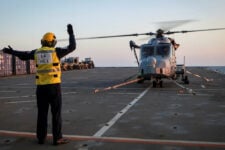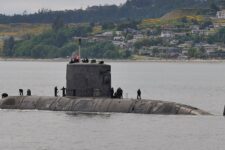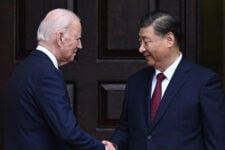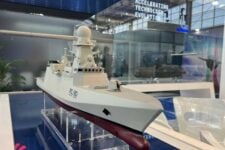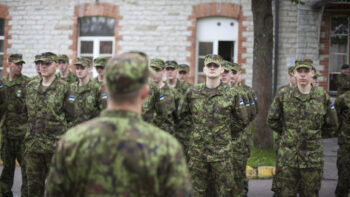
France’s newly appointed Vice-Admiral Nicolas Vaujour reviews French naval troops onboard the Helicopter carrier “Dixmude” at the arsenal in Toulon on August 31, 2023. (Photo by CHRISTOPHE SIMON/AFP via Getty Images)
PARIS — Two years after Australia stunned France by cancelling a multi-billion-dollar submarine contract in favor of the surprise AUKUS security arrangement, the French navy’s new chief of staff says the diplomatic crisis is “now clearly behind us.”
What continues to bind Paris to Canberra and its partners, Adm. Nicolas Vaujour said, is France’s economic and strategic stance in the Pacific, especially with the lingering specter of a wider conflict.
Speaking to defense journalists this week, less than a month into his job, Vaujour explained that “they need us, and we need them because we have interests in common in this area, added to which France has territory in the zone which the others don’t, so our posture is quite different from theirs.”
France has patches of exclusive economic zones (EEZ) in several spots around the world, including a large contingent in the Pacific. In fact, France’s 11.7 million square kilometers of EEZ is the largest in the world, bigger than America’s 11.3 million square kilometers.
For France, its Pacific EEZ sits around four clusters from Clipperton Island off the coast of Mexico, sweeping south and west around French Polynesia, Wallis and Futuna, and New Caledonia off the coast of Australia, meaning France considers Pacific nations, like Australia, neighbors — important ones should war come to the region.
Looking to the future, Vaujour said he thought naval warfare was “possible,” so, he said, “we need to prepare for harder conflicts in wars that we have not chosen but are imposed.” It is therefore “imperious to establish a strategy of access” and to deal with what he euphemistically called “a spillover of power at sea”.
“We need to know, to understand, to contain. And in order to contain we cannot be alone,” he said. “We need to work with partners, notably the United States, the United Kingdom, Italy and others.”
He said he’s worked closely in the past with likely soon-to-be US Chief of Naval Operations Adm. Lisa Franchetti. “We know each other very well and are in daily contact,” he said. He’s already met twice since his appointment on Sept. 1 with Britain’s First Sea Lord, Adm. Sir Ben Key. “Our navy is very similar to the Royal Navy and we have the same challenges,” he remarked.
Vaujour stressed several times during his two-hour breakfast meeting with the Association of Defense Journalists that he considered these partnerships and those with other navies to be absolutely crucial.
“The idea is to avoid exhausting yourself by being on your own. If Italian ships are deployed in the Mediterranean somewhere, then it’s pointless for us to deploy our ships there too. They’re better used being deployed elsewhere as we know we can rely on the Italians, or the Spanish or the Greeks or our other partners,” he stressed.
The aim, he said, is to “create relationships of trust which allows one to say whatever is on one’s mind be it good or bad. You really need to be able to say truthfully to your partners what you’re thinking.”
Making the navy ‘sexy’
Vaujour said one of the problems shared by most modern navies was how to retain personnel. “We need to give youngsters the desire to join the navy, and then to stay, to progress,” he said, quipping, “I need to make the navy sexy!”
More seriously, a key issue is to give navy personnel visibility as to where and when they’ll be deployed so that their families can make arrangements. A scheme known as “the second team”, introduced by the French Navy in 2019 seems to be working well, he said. It means that a number of French ships, but not all, have two complete teams of working personnel, so they’re never stuck in port because of a lack of staff.
One team works aboard ship whilst the other works on land and they swap around every four months. The advantage is two-fold: “First, we know our ships will be able to sail fully staffed. And second our personnel are given visibility and predictability. They know where they’ll be and when. It makes it much easier for their families.”
As to the question of a second French aircraft carrier, Vaujour remarked that even if it would be cheaper to build than the first one, it would nevertheless require a “colossal effort because you need everything that goes with it: support vessels, submarines and personnel.”
He suggested a second carrier was not in the cards anytime soon, noting that “today I can undertake the mission I’m asked to do with the equipment I have.”

